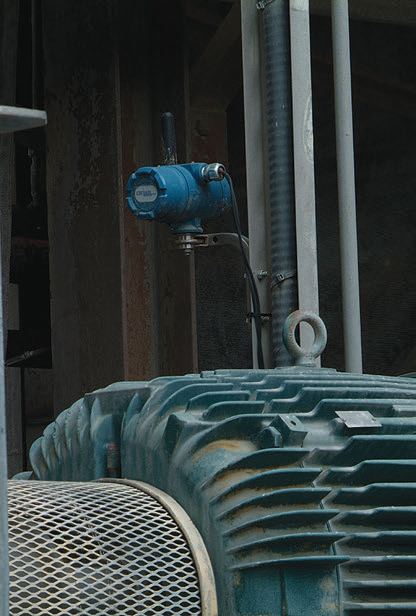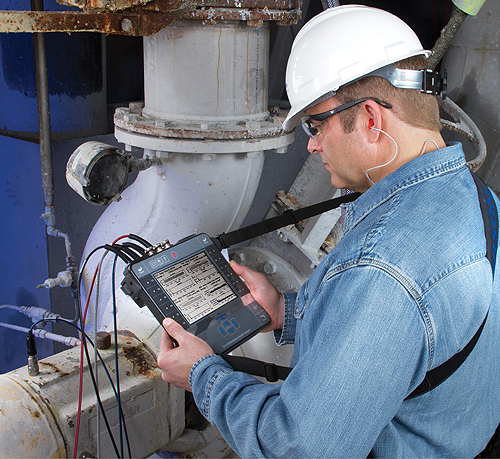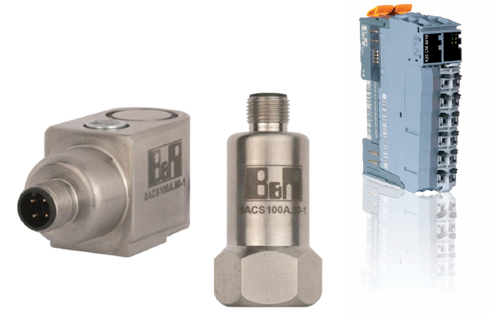By Mary C. Gannon • Diagnostics monitoring programs can prevent lost hours, production and money by alerting maintenance personnel of potential failures in their motion control systems.
Machine uptime is critical in any automation system, whether it be a CNC machine tool or a miles-long conveyor system used in mining. If a machine fails unexpectedly, it could mean thousands or millions of dollars in lost production time and repairs. This is why monitoring systems are critical. And while diagnostic and maintenance systems add to a machine’s initial cost, they could potentially save millions down the road in preventable downtime.
Keep vibration at bay
Keeping an eye on vibration and alignment of rotating equipment, such as bearings and gearboxes, is critical for machine uptime. This is where programs such as Emerson Process Management’s Smart Machinery Health Management or B&R Industrial Automation Corp.’s condition monitoring come into play.

Photo courtesy of Emerson Process Management.
Matt Carpenter, Director of Engineering at B&R, said that its condition monitoring modules do a real-time analysis to detect problems with bearings and monitor the mechanics of that machine by identifying frequencies of the various vibrations. “When they wear, problems can be predicted and isolated before they cause downtime,” Carpenter said. “Bearings have different failure modes. So depending on the type of failure, those frequencies can indicate what type of problem is developing.”

Photo courtesy of Emerson Process Management.
Something for everyone
Condition monitoring is simple and can be done in a variety of ways. For example, Emerson offers three choices in condition monitoring—through portable devices, with online monitoring or through wireless devices, said Tom Francisco, Business Development Manager. With portable devices, a member of a plant’s maintenance staff walks around with a portable device or analyzer that uses a sensor to check a bearing’s health as well as other critical factors, such as heat and fatigue. This is usually done on a schedule, whether it is weekly, monthly or some other set time period.
Emerson’s online monitoring provides continuous data collection. For example, its CSI 6500 Machinery Health Monitor is a continuous monitoring system providing 24/7 data collection. With this device, transient events can be viewed and replayed for further analysis.
Finally, with Emerson’s wireless transmitters, users can interface with existing plant monitoring systems to deliver vibration levels on critical equipment. For example, its Smart Wireless CSI 9420 Wireless Vibration Transmitter can easily connect to a machine and deliver vibration information over the WirelessHART network for use by both operations and maintenance personnel. These transmitters measure vibration, temperature and bearing wear.
Complete a criticality assessment
Francisco said the best way to determine which monitoring system should be used in your application is to use what Emerson refers to as its pyramid of rotating machinery. At the top of the pyramid are your most critical machines—those that are extremely expensive or the only one in your plant; for example, a giant, multi-thousand horsepower turbine. These are machines that must be protected, so Emerson targets them for the online monitoring, often with prediction and protection monitoring.
In the middle ground you will find the bulk of your machines, said Francisco. These are systems that are still critical to your process but don’t require constant monitoring. On the other hand, because there are so many of them, monitoring with a portable data device can be time-consuming and not a great use of a person’s time and in some cases, a safety risk. “With wireless, you have these transmitters with two channels of vibration measurement and it’s a small cost to improve safety,” Francisco said. “So all of a sudden, they have a much less expensive option to get important but hard to reach data.”
Francisco adds that the wireless transmitters can be used temporarily if you have identified a problem area with your portable device.
“You can say, I’ve got a shutdown coming, I need to know if that machine can make it to that shutdown,” he said, “so I’m just going to put this wireless device on there to babysit it until we get there.”
Finally, at the bottom of the pyramid are those routine pieces of equipment that can be easily maintained and replaced. For example, said Francisco, you may have two or three pumps in a row and depending on how fast you’re using them or how often, you can turn one or two off and take one out of service and do maintenance while the process is still running. Those lend themselves to portable data collection.
Similarly, B&R’s condition monitoring uses vibration sensors and bus controllers for an integrated package to look at the status of the controller, the status of the inputs and outputs, and the status of any servo drives. Users can simply just set an alarm on the system if a problem is detected, or with more advanced options, integrate it into some other reporting or notification capability, said Carpenter.

“It’s up to the OEM to decide exactly what they want to do with that information. You could email it, you can make it available on a web browser or you can integrate it with some sort of SCADA system,” Carpenter said. “You can also log maintenance information into databases with our platform as well.
“In terms of diagnostics, our controls platform has a built-in web server because every computing device has a web browser,” Carpenter continued. “We have a web server within our controllers and you can connect to that web server and you can access diagnostic information without having any special software. You can actually collect log information and even perform motion traces all through the web browser.”
A growing need
Since the downturn in 2008-09, companies such as Emerson Process Management have seen their diagnostic services grow, as many companies cut back or eliminated their preventive maintenance programs. So although they were saving money at first, they quickly saw component and machine failures, says Francisco. That’s why Emerson saw their vibration analysis monitoring services expand significantly. B&R also got into the action about two years ago.
Other companies are developing diagnostics and monitoring programs as well, such as Siemens Industry Inc., which developed its Sinumerik Integrate software suite, specifically for its Sinumerik CNCs. Two modules in this software—Access MyMachine and Analyze MyCondition—allow for remote diagnostics and monitoring and proactive maintenance, respectively, said Ryan Legg, Product Manager at Siemens Industry Inc.
Siemens’ Analyze MyCondition provides continuous monitoring and can be set up to have specific triggers, such as alarms noting that a certain temperature has been reached in a motor, for example.
“It’s analyzing different mechanical statistics of the machine, and determining the wear and tear of various mechanical components of the machine,” Legg said. “The goal is to allow the company to have a more proactive and intelligent planned maintenance of the machine, as opposed to running the machine until it goes down and then you have unplanned downtime, which certainly is not a desired situation for any customer.”
And although the software might slightly increase a machine’s cost, it certainly decreases total cost of ownership by improving uptime and productivity. “Companies who take a look at total cost of ownership can really see the value in something like this,” said Legg.
“It is way more advantageous to predict when you need maintenance instead of having an outage, which interrupts production,” said Carpenter, adding that industries with long set up times or perishable products, such as those in packaging or printing, can certainly benefit from diagnostics.
A happy medium
Diagnostics services like these are helping to control costs and keep machines running longer because traditional maintenance techniques were often ineffective. In the past, with reactive maintenance, it often was too late to fix a machine once you heard a bearing vibrating or a motor grinding. So companies turned to preventive maintenance to solve this problem, meaning they would either schedule maintenance based on a calendar or by operating hours. As Emerson’s Francisco notes, however, just because a component is rated for 3000 operating hours doesn’t mean it is going to make it to that point.

Another option was predictive maintenance, similar to the schedule on which you change the oil in your car. That is a good indication of the use interval of the machine but in cases like these, sometimes companies were changing out components and machines that still had a long life in them.
A good comparison for what these proactive maintenance and diagnostic options can do for machine health is an EKG test, said Francisco. “This vibration measurement signature, it’s like the trace on an EKG. A doctor knows what a healthy EKG trace looks like. Similarly, a vibration analyst knows what a healthy vibration signature looks like,” he said. “The predictive technology eliminates a lot of that uncertainty by measuring the machine’s actual condition.”
People are critical
With whatever option you choose, having the right people using the software and analyzing the data is critical. Ideally, companies will have someone on site that knows their processes and can look at the machines and determine what type of diagnostics monitoring they require. Determining the level of criticality includes evaluating how important the machines are based on their cost, the redundancy in the process, and if they fail, what are the potential failure effects—do you lose the whole process, or is there risk to personnel or the environment?
For the next step, it is important to have trained staff that can analyze the data and determine what it means. Emerson’s Francisco said that what often happens is the customer relies on Emerson’s analysts at first to review the data and make the calls. Once they are up to speed nd confident, the customer takes the program back “in house” and can start making their own decisions on maintenance.
Siemens’ CNC diagnostics services rely heavily on people making the right call. For example, Access MyMachine can be linked with an OEM’s service engineers who can log in directly to the machine and remotely see what is going. They can then make a diagnosis, as opposed to powering the machine down, having maintenance take a look and sending out for repair and service.

“The people are generally the part that companies forget about when they’re buying a new system,” Francisco cautioned. “The training is one place where investment can give you a huge payback. Trained people have the confidence to make the big calls. You get much better results from your investment.”
Money talks
The proof is in the pudding, they say, and that’s none truer when a company loses money due to unplanned downtime. For example, Emerson’s Francisco told the tale of a mining application where a gearbox failed, a bearing went out and the machine caught on fire, causing the oil sump to catch on fire. Losing the gearbox and motor would have been expensive in itself but it also destroyed the conveyor tower—the steel structure that supported the conveyor belt. So instead of having a conveyor move minerals 11 miles across the desert, the mining operation had to rely on its old dump trucks, which were slower and also cost a small fortune in fuel.
This conveyor was down for 30 days while all the repairs were made, costing the mining company about $400,000 an hour. Had the company known that the gearbox and bearing were close to failure, it could have prevented this catastrophic loss, said Francisco.
As machines and plant-wide systems become more complex and expensive, it’s necessary to monitor them better for potential failures. Diagnostic services on motion control devices like bearings and gearing can help save millions of dollars each year in unplanned downtime.
Emerson Process Management
www2.emersonprocess.com
B&R Industrial Automation Corp.
www.br-automation.com
Siemens Industry Inc.
www.usa.siemens.com/cnc


Leave a Reply
You must be logged in to post a comment.